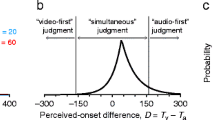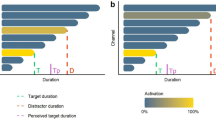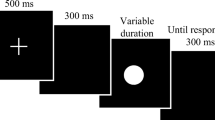Abstract
The two experiments reported examine the role of temporal contiguity on judgments of contingency in a human analogue of the Pavlovian task. The data show that the effect of the actual delay on contingency judgment depends on the observer’s expectation regarding the delay. for a fixed contingency between the cue and the outcome, ratings of the contingency are higher when the actual delay is congruent with the observer’s expectation than when it is incongruent. We argue that our data can be understood within the context of the temporal coding hypothesis.
Similar content being viewed by others
References
Allan, L. G. (1980). A note on measurement of contingency between two binary variables in judgment tasks.Bulletin of the Psychonomic Society, 15, 147–149.
Allan, L. G. (1993). Human contingency judgments: rule-based or associative?Psychological Bulletin, 114, 435–448.
Allan, L. G. (2003). Assessing Power PC.Learning and Behavior, 31, 192–204.
Allan, L. G., Balsam, P., Church, R. M., & Terrace, H. (2002). John Gibbon: obituary.American Psychologist, 57, 436–437.
Allan, L. G., & Church, R. M. (2002). Introduction.Learning and Motivation: 33, 9. Special Issue to honor the work of John Gibbon.
Buehner, M. J., & May, J. (2002). Knowledge mediates the timeframe of covariation assessment in human causal induction.Thinking & Reasoning, 8, 269–295.
Buehner, M. J. & May, J. Rethinking temporal contiguity and the judgment, of causality: Effects of prior knowledge, experience, and reinforcement procedure.Quarterly Journal of Experimental Psychology A. 56 865–890
Dickinson, A. (2001). Causal learning: An associative analysis.Quarterly Journal of Experimental Psychology, 54B, 3–25.
Hagmayer, Y., & Waldmann, M. R. (2003). How temporal assumptions influence causal judgments.Memory & Cognition, 30, 1128–1137.
Hall, G., & Pearce, J. M. (1979). Latent inhibition of a CS during CS-US pairings.Journal of Experimental Psychology: Animal Behavior Processes, 5, 31–42.
Miller, R. R., & Barnet, R. C. (1993). The role of time in elementary associations.Current Directions in Psychological Science, 2, 106–111. Pearce, J. M. (1987). A model of stimulus generalization for Pavlovian conditioning.Psychological Review, 94, 61–73.
Reed, P. (1992). Effect of a signaled delay between an action and outcome on human judgment of causality.Quarterly Journal of Experimental Psychology, 44B, 81–100.
Reed, P. (1996). No evidence for blocking in human judgments, of causality by stimuli presented during an outcome delay.Learning and Motivation, 27, 317–333.
Rescorla, R. A., & Wagner, A. R. (1972). A theory of Pavlovian conditioning: Variations in the effectiveness of reinforcement and non-reinforcement. In A. H. Black & W. F. Prokasy (Eds.),Classical conditioning II: Current theory and research (pp. 64–99). New York: Appleton-Century-Crofts.
Savastano, H. I., & Miller, R. R. (1998). Time as content in Pavlovian conditioning.Behavioural, Processes, 44, 147–162.
Savastano, H. I., Yin, H., Barnet, R. C., & Miller, R. R. (1998). Temporal coding in Pavlovian conditioning: Hall-Pearce negative transfer.Quarterly Journal of Experimental Psychology, 51B, 139–153.
Shanks, D. R. (1989). Selectional processes in causality judgment.Memory & Cognition, 17, 27–34.
Shanks, D. R., & Dickinson, A. (1991). Instrumental judgment and performance under variations in action-outcome contingency and contiguity.Memory & Cognition, 19, 353–360.
Shanks, D. R., Pearson, S. M., & Dickinson, A. (1989). Temporal contiguity and the judgment of causality by human subjects.Quarterly Journal of Experimental Psychology, 41B, 139–159.
Tangen, J. M., & Allan, L. G. The relative effect of cue interaction.Quarterly Journal of Experimental Psychology B. 56 279–300.
Wasserman, E. A., & Neunaber, D. J. (1986). College students’ responding to and rating of contingency relations: The role of temporal contiguity.Journal of the Experimental Analysis of Behavior, 46, 15–35.
Wagner, A. R. (1981). SOP: A model of automatic memory processing in animal behavior. In N. E. Spear and R. R. Miller (Eds.),Information processing in animals: Memory mechanisms (pp. 5–47). Hillsdale, NJ: Erlbaum.
Author information
Authors and Affiliations
Corresponding author
Rights and permissions
About this article
Cite this article
Allan, L.G., Tangen, J.M., Wood, R. et al. Temporal contiguity and contingency judgments: A Pavlovian analogue. Integrative Physiological & Behavioral Science 38, 214–229 (2003). https://doi.org/10.1007/BF02688855
Issue Date:
DOI: https://doi.org/10.1007/BF02688855




